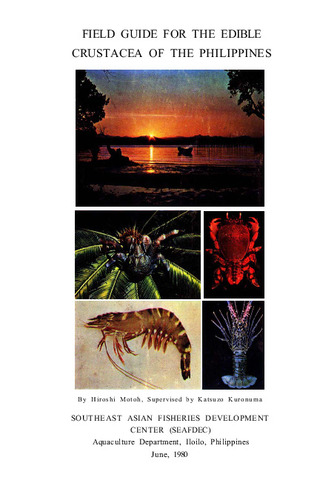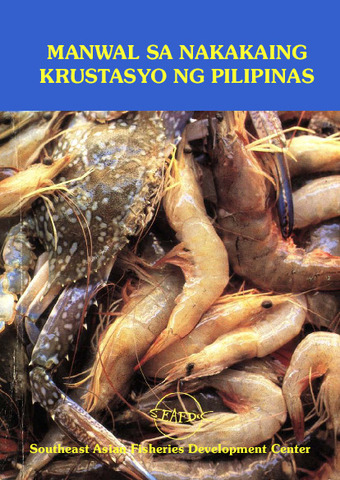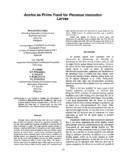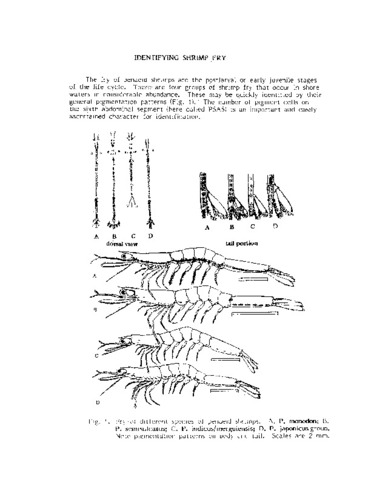Field guide for the edible crustacea of the Philippines
- Global styles
- MLA
- Vancouver
- Elsevier - Harvard
- APA
- Help

วันที่
1980ผู้เขียน
Page views
18,194ASFA keyword
AGROVOC keyword
Taxonomic term
เมตาดาต้า
แสดงระเบียนรายการเต็มShare
นามธรรม
Information on each species includes: 1) taxonomy (scientific, English and Philippine names) and diagnostic characters: 2) ecology; 3) distribution; 4) fisheries data; 5) economics (potential, price).
Description
A pictorial handbook, Field Guide for the Edible Crustacea of the Philippines was written by Mr. Hiroshi Motoh, leader of the ecology project of the Aquaculture Department, with the supervision of Dr. Katsuzo Kuronuma, president emeritus of Tokyo University of Fisheries. This handbook describes 37 species of common edible crustacea, belonging to the order Decapoda, which are found in the Philippines. Fourteen of the species are commonly known as prawns or shrimps, 8 are lobsters or crayfish, and 15 are crabs. A color plate of each species accompanies biological, ecological, taxonomic, and economic descriptions.
Each species presented is discussed under six major topics: Name (the scientific, English, and Philippine names are given); Diagnostic characters by which the species is identified; Ecology referring to the habitat, behavior, etc. of each species; Geographical distribution of species; its Fisheries which includes fishing gear used to catch it and known fishing grounds; and the Economic potential of the species.
An immediate practical use of the handbook is to pint out the aquaculture value of the species and their requirements for culture or eventual culture. Besides aquaculturists, it will also benefit nature lovers, students, and amateur scientists to read the handbook; the classification scheme by which the species were arranged is provided in a systematic list.
While the title suggests that the species dealt with are commonly found in the Philippines, most are also found in Hawaii, Japan, Taiwan, and Southeast Asia, westward to the Arabian Gulf, Red Sea, and the East Coast of Africa. The area covered is commonly known as Indo-Pacific Region or Indo-West Pacific Region in zoogeography.
Printed in Japan, it consists of 96 pages and 37 color plates.
Other versions
Filipinoการอ้างอิง
Motoh, H. & Kuronuma, K. (1980). Field guide for the edible Crustacea of the Philippines. Iloilo, Philippines: Aquaculture Department, Southeast Asian Fisheries Development Center.
Contents
Foreword. -- Introduction -- Acknowledgement -- Notes on presentation -- Identification of the species -- Glossary of technical terms -- List of the species arranged in systematic order -- Descriptions and illustrations -- References -- Index to scientific names -- Index to English names -- Index to Philippine names.
Type
BookFormat
ii, 96 p. : ill. (col.).
คอลเลกชัน
- Handbooks [6]
Related items
Showing items related by title, author, creator and subject.
-
Series: SAFIS manual; No. 22
Manwal sa nakakaing krustasyo ng Pilipinas
Motoh, Hiroshi (Aquaculture Department, Southeast Asian Fisheries Development Center, 1986)Text in Filipino. -
Acetes as prime food for Penaeus monodon larvae
Kungvankij, Pinij; Tacon, Albert G.; Corre, K.; Pudadera, B. P.; Taleon, G.; Borlongan, E.; Potestas, I. O. (Asian Fisheries Society, 1986)This paper presents research attempts to develop a suitable artificial diet for shrimp larvae with locally-available materials. Larval rearing experiments using finely ground Acetes tissues conducted under various climatic ... -
Identifying shrimp fry
Southeast Asian Fisheries Development Center, Aquaculture Department (Aquaculture Department, Southeast Asian Fisheries Development Center, 1988)






